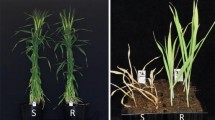Abstract
Genetic resistance to race alpha of C. lindemuthianum in the nine varieties of beans studied can be accounted for by dominant alleles at either of two loci, which are unlinked and which behave as duplicate factor loci in the classical sense. A similar system of loci governs reaction to races beta and gamma, with evidence favoring multiple allelism and dominance of alleles conferring susceptibility in certain instances in the case of beta. In addition, for reaction to races beta and gamma, there are distinct systems of complementary factors, again with multiple allelism at the beta loci. Finally, there is genetic linkage between genes of the duplicate factor set governing reaction to gamma and genes of the duplicate factor set, and complementary factor set conditioning reaction to beta. The genes that are members of the set(s) pertaining to any one race alone are independent of each other in a linkage sense.
Similar content being viewed by others
References
Allard, R. W., 1956. Formulas and tables to facilitate the calculation of recombination values in heredity. Hilgardia 24:235–278.
Andrus, C. F. and Wade, B. L., 1942. The factorial interpretation of anthracnose resistance in beans. U.S.D.A. Tech Bull. 810, 29 pp., illus.
Burkholder, W. H., 1918. The production of an anthracnose-resistant White Marrow bean. Phytopath 8: 353–359.
McRostie, G. P., 1919. Inheritance of anthracnose resistance as indicated by a cross between a resistant and a susceptible bean. Phytopath 9: 141–148.
McRostie, G. P., 1921. Inheritance of disease resistance in the common bean. Jour. Am. Soc. Agron. 13: 15–32.
Schreiber, F., 1932. Resistenzzüchtung bei Phaseolus vulgaris. Phytopath. Zeitschr. 4:415–454.
Schreiber, F., 1933. Resistenz-Züchtung bei Buschbohnen. Kühn-Arch. 38:287–292.
Walker, H. M. and Lev, J., 1953. Statistical Inference. 81–88 pp. Henry Holt and Co., New York.
York, L. Y., 1950. Studies on anthracnose resistance in beans. PhD. Thesis, unpublished. Cornell University.
Additional information
Paper based on work conducted by the senior author in partial fulfilment of requirements for the Doctor of Philosophy degree at Michigan State University and supported by the Rockefeller Foundation.
Formerly Rockefeller Foundation Student in Crop Science, now Director, Instituto Nacional de Investigaciones Agricolas, Veracruz, Mexico; Professor of Crop Science, Michigan State University; and Research Pathologist, Crops Research Division, Agricultural Research Service, USDA.
Rights and permissions
About this article
Cite this article
Cardenas, F., Adams, M.W. & Andersen, A. The genetic system for reaction of field beans (Phaseolus vulgaris L.) to infection by three physiologic races of Colletotrichum lindemuthianum . Euphytica 13, 178–186 (1964). https://doi.org/10.1007/BF00033307
Received:
Issue Date:
DOI: https://doi.org/10.1007/BF00033307



